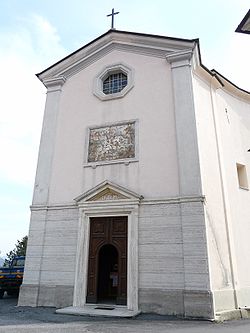Bormida (SV)
| Bormida | |
|---|---|
| Comune | |
| Comune di Bormida | |

Church of Saint George
|
|
| Location of Bormida in Italy | |
| Coordinates: 44°17′N 8°14′E / 44.283°N 8.233°ECoordinates: 44°17′N 8°14′E / 44.283°N 8.233°E | |
| Country | Italy |
| Region | Liguria |
| Province / Metropolitan city | Savona (SV) |
| Frazioni | Chiesa, Fornelli, Piano Soprano, Piano Sottano, Resi, Costa, Pirotti, Navoni-Balteria, Romano |
| Government | |
| • Mayor | Bruna Cambise In Falciani (elected June 13, 2004) |
| Area | |
| • Total | 22.43 km2 (8.66 sq mi) |
| Elevation | 485 m (1,591 ft) |
| Population (31 December 2006) | |
| • Total | 453 |
| • Density | 20/km2 (52/sq mi) |
| Demonym(s) | Bormidesi |
| Time zone | CET (UTC+1) |
| • Summer (DST) | CEST (UTC+2) |
| Postal code | 17040 |
| Dialing code | 019 |
| Patron saint | Saint George |
| Saint day | 23 April |
Bormida (Bormia in Ligurian), with a population of 453 spread over an area of 22.4 square kilometres (8.6 sq mi), is a rural commune of the Province of Savona in the Italian region Liguria. The commune is a member of the Comunità Montana Alta Val Bormida.
Bormida is about 20 kilometres (12 mi) west of Savona (as the crow flies) in the upper Val Bormida between the mountain peaks of Settepani, elevation 1,386 metres (4,547 ft), and Ronco di Maglio, elevation 1,108 metres (3,635 ft). The Bormida di Pallare, a tributary of the Bormida di Spigno, flows through its territory.
Bormida borders the communes of Calice Ligure, Calizzano, Mallare, Osiglia, Pallare, and Rialto.
Bormida probably came into existence in the medieval period. However it does not appear in the documentary record until 1549 when Alfonso Del Carretto, lord of Finale Ligure, conceded certain privileges to the local population in a deed.
In 1713, following a period of domination by the Spanish army, Bormida fell under the jurisdiction of the Republic of Genoa. Later in that century it acquired the status of a commune in its own right, rather than being a part of the commune of Osiglia, and was almost completely destroyed by the French army of Napoleon Bonaparte during his first Italian campaign.
From 1815 it followed the fortunes of the Kingdom of Sardinia, becoming part of the Kingdom of Italy in 1860.
...
Wikipedia

